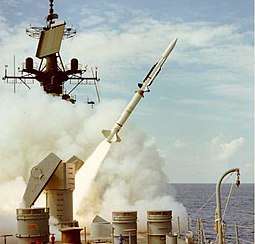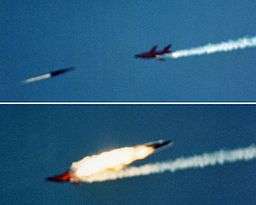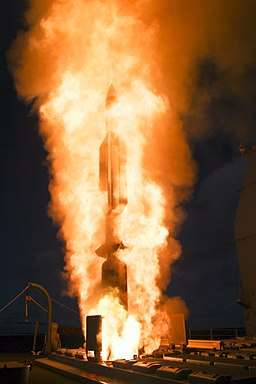RIM-67 Standard
The RIM-67 Standard ER (SM-1ER/SM-2ER) is an extended range surface-to-air missile (SAM) and anti ship missile originally developed for the United States Navy (USN). The RIM-67 was developed as a replacement for the RIM-8 Talos, a 1950s system deployed on a variety of USN ships, and eventually replaced the RIM-2 Terrier as well, since it was of a similar size and fitted existing Terrier launchers and magazines. The RIM-66 Standard MR was essentially the same missile without the booster stage, designed to replace the RIM-24 Tartar. The RIM-66/67 series thus became the US Navy's universal SAM system, hence the "Standard Missile" moniker.
| RIM-67 Standard ER | |
|---|---|
| Type | Extended range surface-to-air missile with anti-ship capability |
| Place of origin | United States |
| Service history | |
| In service | 1981-present (RIM-67B), 1999-present (RIM-156A) |
| Production history | |
| Unit cost | $409,000 |
| Specifications | |
| Mass | 2,980 lb (1,350 kg) |
| Length | 26.2 ft (8.0 m) |
| Warhead | Proximity fuse, high explosive 137 lb (62 kg) continuous rod, later blast fragmentation |
| Engine | Two-stage, solid-fuel rocket; sustainer motor and booster motor |
| Wingspan | 5 ft 2 in (1.57 m) |
Operational range | 65–100 nmi (120–185 km) |
| Flight ceiling | 80,200 ft (24,400 m) |
| Maximum speed | Mach 3.5 |
Guidance system | Inertial/SARH |
Launch platform | Surface Ship |
RIM-67A SM-1 Extended Range
The RIM-67A (SM-1ER Block I) was the Navy's replacement for RIM-8 Talos missile. Improved technology allowed the RIM-67 to be reduced to the size of the earlier RIM-2 Terrier missile. Existing ships with the Mk86 guided missile fire control system, or "Terrier" were adapted to employ the new missile in place of the older RIM-2 Terrier missile. Ships that switched from the RIM-2 Terrier to the RIM-67A were still referred to as Terrier ships even though they were equipped with the newer missile.
RIM-67B and RIM-156 SM-2 Extended Range
The second generation of Standard missile, the Standard Missile 2, was developed for the Aegis combat system, and New Threat Upgrade program that was planned for existing Terrier and Tartar ships. The destroyer USS Mahan served as the test platform for the development of the CG/SM-2 (ER) missile program project. The principal change over the Standard missile 1 is the introduction of inertial guidance for each phase of the missile's flight except the terminal phase where semi-active homing was retained. This design change was made so that missiles could time share illumination radars and enable equipped ships to defend against saturation missile attacks.
Terrier ships reequipped as part of the New Threat Upgrade were refit to operate the RIM-67B (SM-2ER Block II) missile. However, Aegis ships were not equipped with launchers that had space enough for the longer RIM-67B.
The RIM-156A Standard SM-2ER Block IV with the Mk 72 booster was developed to compensate for the lack of a long range SAM for the Ticonderoga class of Aegis cruisers. The Mk72 booster allows the RIM-156A to fit into the Mk41 guided missile launch system. This configuration can also be used for Terminal phase Ballistic Missile Defense.[1]
_on_1_March_1983_(6370831).jpg)
There was a plan to build a nuclear armed standard missile mounting a W81 nuclear warhead as a replacement for the earlier Nuclear Terrier missile (RIM-2D). The USN rescinded the requirement for the nuclear armed missile in the 1980s, and the project was canceled.[2]
The Standard can also be used against ships, either at line-of-sight range using its semi-active homing mode, or over the horizon using inertial guidance and terminal infrared homing.[3]
RIM-174 Standard Missile 6 ERAM is a new generation of Standard extended range missiles, which became operational in 2013.
Operational history
During the Iran–Iraq War (1980–1988) the United States deployed Standard missiles to protect its navy, as well as other ships in the Persian Gulf from the threat of Iranian attacks. According to the Iranian Air Force, its F-4 Phantom IIs were engaged by SM-2ERs but managed to evade them, with one aircraft sustaining non-fatal damage due to shrapnel.[4] During the same war the United States Navy mistakenly shot down an Iranian civilian airliner, Iran Air Flight 655 using two SM-2 missiles.
On April 18, 1988, during Operation Praying Mantis, the frigate USS Simpson fired four RIM-66 Standard missiles and the cruiser USS Wainwright fired two RIM-67 Standard missiles at Joshan, an Iranian (Combattante II) Kaman-class missile boat. The attacks destroyed the Iranian ship's superstructure but did not sink it.
An 18 July 2015 test firing damaged the destroyer USS The Sullivans, restricting the older SM-2s to wartime use only.[5]
Deployment


RIM-67 Standard was deployed on ships of the following classes, replacing the RIM-2 Terrier, and it never was VLS-capable. All of the ships used the AN/SPG-55 for guidance. The Mk10 guided missile launching system was used as the launching system. New Threat Upgrade equipped vessels operated the RIM-67B which used inertial guidance for every phase of the intercept except for the terminal phase where the AN/SPG-55 radar illuminates the target.
- USS Long Beach SM-1ER later SM-2ER with NTU.
- Farragut-class destroyers SM-1ER later SM-2ER with NTU (USS Mahan only).
- Leahy-class cruisers SM-1ER later SM-2ER with NTU.
- USS Bainbridge SM-1ER later SM-2ER with NTU.
- Belknap-class cruisers SM-1ER later SM-2ER with NTU.
- USS Truxtun SM-1ER later SM-2ER with NTU.
- Italian cruiser Vittorio Veneto SM-1ER Only.
The RIM-156 Standard Block IV, is a version that has been developed for Aegis Combat System it has a smaller compact sized booster stage for firing from the Mk41 Guided missile launch system. Like the earlier RIM-67B it employs inertial/command guidance with terminal semi-active homing.
- Ticonderoga-class cruisers (VLS units only)
- Arleigh Burke-class destroyers
The last vessel to operate the RIM-67 was the Italian cruiser Vittorio Veneto which was retired in 2003. The RIM-174 Standard ERAM or Standard Missile Six has superseded the RIM-156A in production. The RIM-156A remains in service as of 2010.
RIM-67 Standard missiles have been withdrawn from service, remaining rounds are being re-manufactured in to GQM-163 Coyote supersonic targets.
Surface to air variants

| Designation | Block | Notes |
|---|---|---|
| RIM-67A | SM-1ER Block I | Terrier Upgrade
|
| RIM-67B | SM-2ER Block I | New Threat Upgrade. Entered service in 1980.
|
| RIM-67C | SM-2ER Block II | New Threat Upgrade
|
| RIM-67D | SM-2ER Block III | New Threat Upgrade
|
| RIM-67D | SM-2ER Block IIIC[6] | New Threat Upgrade for advanced anti-ship missiles and aircraft
|
| RIM-156A
(ex-RIM-67E) |
SM-2ER Block IV | Designed for Aegis VLS ships. Initial Operational Capability was declared in August 1999.
|
| RIM-156B | SM-2ER Block IVA | Designed for modified Aegis VLS ships capable of tracking both TBM's and aircraft.
Cancelled as a part of the whole NATBMD program in December 2001. |
Gallery
%2C_circa_in_July_1990_(6468165).jpg) Blue training missiles on the rails of a MK-10 GMLS on USS Josephus Daniels
Blue training missiles on the rails of a MK-10 GMLS on USS Josephus Daniels_on_1_July_1986_(6421956).jpg) USS Worden showing the Mk 10 GMLS. Note the launcher at left, the blast doors behind launcher where the missiles exit the launcher feeder and AN/SPG-55 radars at middle right.
USS Worden showing the Mk 10 GMLS. Note the launcher at left, the blast doors behind launcher where the missiles exit the launcher feeder and AN/SPG-55 radars at middle right._on_1_March_1983_(6370832).jpg) An SM-2ER in the magazine area, on a ready service ring of the Mk-10 GMLS on Mahan
An SM-2ER in the magazine area, on a ready service ring of the Mk-10 GMLS on Mahan_launches_a_Standard_Missile-2_while_conducting_torpedo_evasion_maneuvers_during_Multi-Sail_2009.jpg) The guided-missile destroyer USS Curtis Wilbur launches a RIM-156 Standard SM-2 ER missile while conducting torpedo evasion maneuvers during Multi-Sail 2009
The guided-missile destroyer USS Curtis Wilbur launches a RIM-156 Standard SM-2 ER missile while conducting torpedo evasion maneuvers during Multi-Sail 2009
See also
- RIM-2 Terrier – predecessor
- RIM-8 Talos – predecessor
- RIM-24 Tartar
- AGM-78 Standard ARM
- RIM-66 Standard Medium Range
- RIM-161 Standard SM-3
- RIM-174 Standard ERAM – successor
References
- Aegis BMD Project Office. Standard missile. Accessed September 26, 2009.
- Raytheon RIM-67 Standard ER
- Canadian Forces Maritime Command. Standard missile Archived 2007-12-09 at the Wayback Machine. Accessed June 5, 2006.
- "Archived copy". Archived from the original on 2008-03-18. Retrieved 2008-02-16.CS1 maint: archived copy as title (link). Accessed October 7, 2007.
- LaGrone, Sam (27 July 2015). "Navy Restricts Use of 'A Number' of SM-2 Missiles Following USS The Sullivans Launch Failure". usni.org. USNI. Retrieved 27 July 2015.
- https://finance.yahoo.com/news/raytheon-wins-149m-navy-deal-221710555.html
External links
| Wikimedia Commons has media related to RIM-67 Standard ER. |